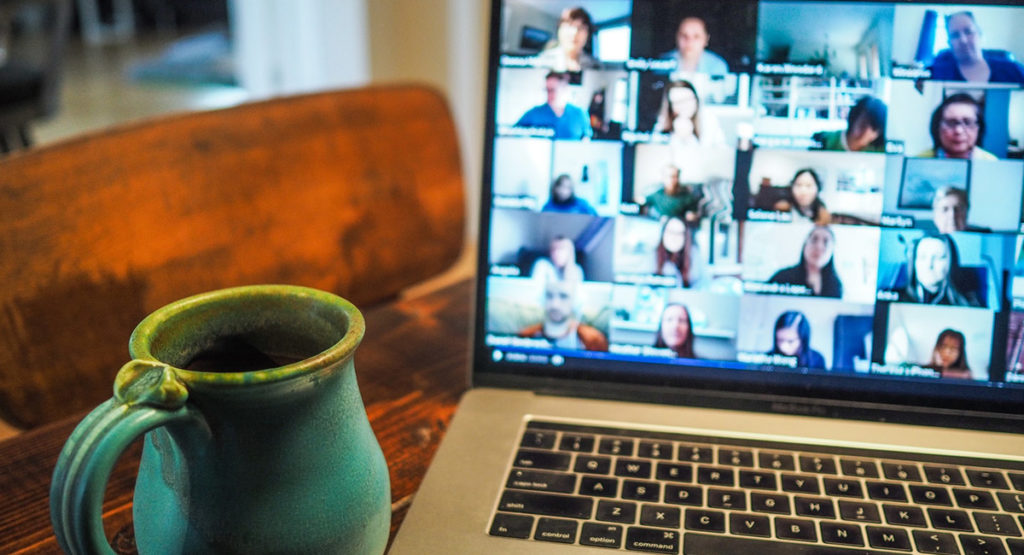19 Mar Media training in the time of zoom
By Tammy Taylor and Anita-Marie Laurie, Sitrick And Company
Turn on any news broadcast and you will see an anchor conducting a remote video interview or a reporter talking to someone in their story through a computer screen. Covid has changed the way we do a lot of things, including the television interview; and if it’s not with the six-foot mic stick out in the field, it’s through WebEx, Skype or some other video conferencing service in the studio. Print and online reporters almost never do interviews in person anymore either. So that means a rethink on media training and a pivot to conducting it just the way the interviews are done – remotely through everyone’s new best meeting friend, Zoom.

Back during “normal times,” the best way to prepare a client for an interview would be in person, with a teaching session, drill down on messaging and practice interview(s) recorded on video and immediately reviewed and analyzed. Social distancing makes that difficult for several reasons. In-person meetings (and travel to them, for that matter) still seem far down the road, even with vaccinations ramping up all across the country. And coaching in-person would still involve masks, which block those ever-important facial expressions.
Don’t be discouraged by the idea of Media Training through Zoom. We make it work as well as in-person sessions and we make sure our client is well prepared to address every situation that could arise during any potentially difficult, uncomfortable, or downright hostile circumstance. Whether it’s an interview with a reporter, speech, or other type of public appearance, teaching a client how to control the Q&A session and bridge back to key messages works pretty much the same on Zoom as it does across the conference table.
We have often found one of the most valuable portions of the media training turns out to be what we call the “drill down” on messaging, which actually takes place throughout the session. What sounds like a client’s good “Talking Point” to begin with sometimes does not sound so great coming out of someone’s mouth, and the work to refine it as we talk it all through and do “mock interviews” really enhances the message.
So, through Zoom, the trainee can still learn how to deflect “tough” questions and circle back to key messages, how to be succinct in answers, and receive other key pointers which add to confidence and success. We also provide tips on physical features; how to dress, posture and body language, and where and how to look on a remote camera.
Now it is time for the practice interview session and that is a little trickier on Zoom. Normally we would shoot the mock interview on video, then immediately review and analyze the video together in the same room to see what worked well in terms of messaging, delivery, and physical appearance. We also discuss in detail what needs improving, whether that is refining messages, vocal issues, distractive physical mannerisms (hands, playing with hair, scratching your nose) or simply remaining calm, cool, and collected. But the Zoom app itself does not allow immediate playback. So, we turn to a couple of alternatives that work really well. One is to have a video camera pointed at the computer screen to record the interview subject and play it back off the camera’s monitor. That way everyone can easily see the interview right away and offer the instant feedback that is needed.
Just as in the previous in-person practice sessions, the interviews and playbacks can be repeated as many times as necessary, until the client is comfortable and confident, and all are satisfied with the result. Because when it comes to nailing down the messages and bridging back to them, practice makes perfect.
But wait! There’s more! Just as words can leave a lasting impression, so can what viewers observe in the background. Be sure to be mindful of your subject’s background; that it is not cluttered or there is nothing embarrassing for a viewer to see. People pay special attention to backgrounds now, especially because many interviews take place in people’s homes; so much so that many have come to recognize the backgrounds of certain interview subjects on various networks more so than the interviewees themselves. “Oh yes, this is the woman with the white fireplace and plants on either side of the mantel. I think her name is A.J.” And if your client happens to end up on Room Rater — at least they might get a decent score! Also, keep your interview free of unintended visitors whether it’s your dog, cat, child or wandering spouse.
As Members of the Firm for more than 20 years, we have media trained dozens of clients for Sitrick And Company, which has a long and successful history of handling high-stakes strategic communications for high-profile companies and individuals during defining moments, either in the court of law or the court of public opinion. In these situations, our clients often find themselves in high-pressure interview situations with top tier media such as the Wall Street Journal, New York Times, 60 Minutes, 20/20, CNN, The Today Show and others. In our firm’s 32 years of practice, we have found media training is often critical to success.




